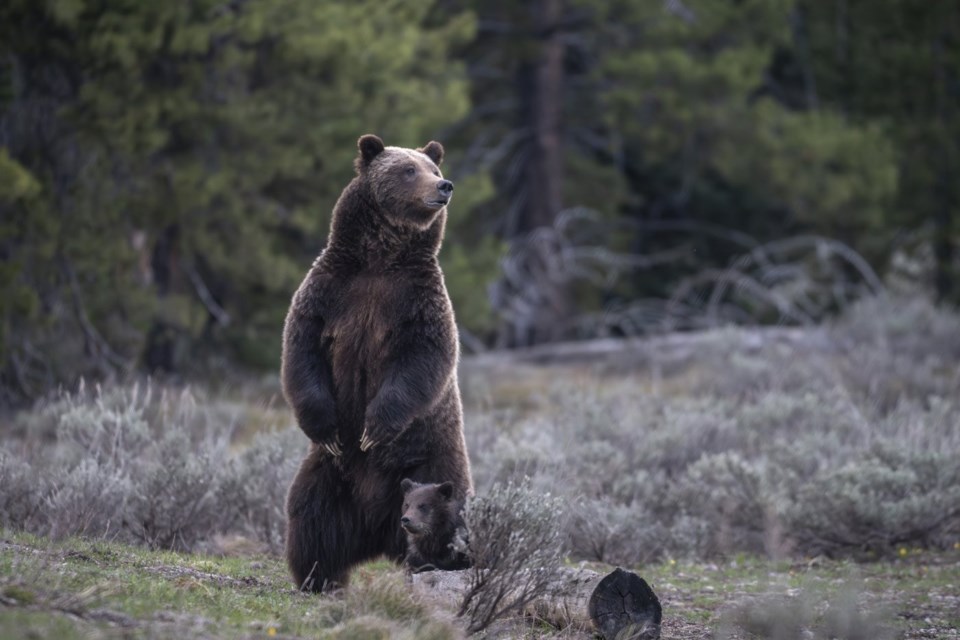CHEYENNE, Wyo. (AP) — Environmental groups are asking the U.S. government to do more to protect Rocky Mountain grizzly bears before the next Trump administration decides the big bruins’ future.
The groups petitioned the U.S. Fish and Wildlife Service on Wednesday to take steps to connect the bears' separate populations. They want federal wildlife officials to encourage grizzlies to roam from the Yellowstone ecosystem in Wyoming across parts of Idaho and Montana to the area in and around Glacier National Park.
“Overwhelming scientific consensus agrees that a naturally connected metapopulation of grizzly bears will lead to improved genetic diversity and greater demographic resiliency of the species,” says the petition submitted by Earthjustice lawyers on behalf of 14 groups including the Sierra Club and Humane Society of the United States.
Expanding the habitat of grizzlies doesn't sit well with many ranchers whose cattle and sheep can be their prey. Ranchers plan to press President Donald Trump's incoming administration to remove protections for bears — not encourage their spread.
Not every place where grizzlies might roam is suitable for them, said Jim Magagna, executive vice president of the Wyoming Stock Growers Association.
“As the population gets out of hand — which we believe it’s doing at this point — yes, they start to expand into other areas but they’re not natural areas for grizzly bears,” Magagna said Wednesday. ”They therefore present more of a problem."
Fish and Wildlife faces a court-imposed deadline of Jan. 20 — the same day Trump will retake office — to decide whether to continue to protect grizzlies as a federally designated threatened species. U.S. District Judge Alan Johnson in Cheyenne set the date on Friday, almost a year after the service missed its own deadline to decide the matter.
Fish and Wildlife officials didn't immediately respond to a request for comment on Wednesday's petition.
The previous Trump administration briefly removed federal protections for grizzly bears by courts. Wyoming, Montana and Idaho all still seek to have grizzlies' federal protection removed in favor of state management. That would likely lead to new plans for grizzly hunting, similar to how the three states now allow the hunting of wolves that were reintroduced to the region.
Grizzlies are North America's biggest bears, after polar bears. And while Alaska hosts the biggest grizzlies, those in the Lower 48 states can still top 600 pounds (270 kilograms).
Since their listing as federally protected threatened species in 1975, the Rocky Mountain grizzly population has doubled to around 2,000 animals. But they still face a range of threats, and the 73 grizzly deaths attributed to or possibly caused by people in the Yellowstone region this year are the most on record, according to Earthjustice.
Wildlife managers do often kill bears that habitually raid trash and other sources of human food and become a safety risk. Others are struck on roads and shot accidentally or in self-defense by hunters, the groups point out in their petition.
In October, the death of arguably the world's — No. 399, a 28-year-old female that birthed at least 18 cubs over the years — highlighted the risks of vehicle traffic. No. 399 by spending a lot of her time with her cubs near roads in nearby Grand Teton National Park before she was killed by a Subaru on a road south of Jackson, Wyoming.
Encouraging the population to connect beyond the areas grizzlies currently inhabit full-time would improve their genetic diversity and make them more resilient to threats including habitat loss and climate change, according to the petition.
The document draws on a plan by Chris Servheen, who was Fish and Wildlife’s grizzly bear recovery coordinator from 1981 until his retirement in 2016. Servheen updated the 1993 recovery plan he developed for the service. He links the fate of grizzlies to that of wolves in Wyoming, Montana and Idaho. The bears, whose territory overlaps with wolf habitat, need more protection from neck snares intended for wolves, he pointed out in a call with reporters.
His new plan applies only if grizzlies remain federally protected, however.
“If they delisted all of the grizzly bears, the game is over for grizzly bears and it wouldn’t be a recovery plan,” Servheen said.
Mead Gruver, The Associated Press



